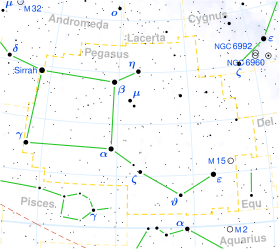Upsilon Pegasi
| Observation data Epoch J2000 Equinox J2000 | |
|---|---|
| Constellation | Pegasus |
| Right ascension | 23h 25m 22.78350s[1] |
| Declination | 23° 24′ 14.7606″[1] |
| Apparent magnitude (V) | 4.40[2] |
| Characteristics | |
| Spectral type | F8III[3][4] |
| U−B color index | +0.14[2] |
| B−V color index | +0.61[2] |
| Astrometry | |
| Radial velocity (Rv) | -8.59[5] km/s |
| Proper motion (μ) | RA: +192.19[1] mas/yr Dec.: +36.12[1] mas/yr |
| Parallax (π) | 19.14 ± 0.18[1] mas |
| Distance | 170 ± 2 ly (52.2 ± 0.5 pc) |
| Absolute magnitude (MV) | 0.83[6] |
| Details | |
| Mass | 2.17[7] M☉ |
| Radius | 6.0[7] R☉ |
| Luminosity | 42.35[6] L☉ |
| Surface gravity (log g) | 3.22[7] cgs |
| Temperature | 5,888[7] K |
| Metallicity [Fe/H] | -0.01[6] dex |
| Rotational velocity (v sin i) | 33.7[8] km/s |
| Other designations | |
| Database references | |
| SIMBAD | data |
Upsilon Pegasi (υ Pegasi, abbreviated Ups Peg, υ Peg), also named Alkarab,[9] is a star in the constellation of Pegasus. Its apparent magnitude is 4.40[2] and it is approximately 170.4 light-years distant from the Sun based on parallax.[1]
Nomenclature
υ Pegasi (Latinised to Upsilon Pegasi) is the star's Bayer designation.
The star bore the traditional Arabic name Al Karab ("the Bucket-rope").[10] In 2016, the IAU organized a Working Group on Star Names (WGSN)[11] to catalog and standardize proper names for stars. The WGSN approved the name Alkarab for this star on 5 September 2017 and it is now so included in the List of IAU-approved Star Names.[9]
Properties
Upsilon Pegasi is a spectral class F8III[3][4] yellow-white giant star.
Its iron abundance is -0.01 (97.7% of the Sun). It is moving through the Galaxy at a speed of 50.6 km/s relative to the Sun. Its projected Galactic orbit carries it between 18,600 and 26,300 light-years from the center of the Galaxy. [12]
References
- 1 2 3 4 5 6 Van Leeuwen, F. (2007). "Validation of the new Hipparcos reduction". Astronomy and Astrophysics. 474 (2): 653. arXiv:0708.1752. Bibcode:2007A&A...474..653V. doi:10.1051/0004-6361:20078357. Vizier catalog entry
- 1 2 3 4 Ducati, J. R. (2002). "VizieR Online Data Catalog: Catalogue of Stellar Photometry in Johnson's 11-color system". CDS/ADC Collection of Electronic Catalogues. 2237. Bibcode:2002yCat.2237....0D.
- 1 2 Hoffleit, D.; Warren, W. H. (1995). "VizieR Online Data Catalog: Bright Star Catalogue, 5th Revised Ed. (Hoffleit+, 1991)". VizieR On-line Data Catalog: V/50. Originally published in: 1964BS....C......0H. 5050. Bibcode:1995yCat.5050....0H.
- 1 2 Gray, R. O.; Napier, M. G.; Winkler, L. I. (2001). "The Physical Basis of Luminosity Classification in the Late A-, F-, and Early G-Type Stars. I. Precise Spectral Types for 372 Stars". The Astronomical Journal. 121 (4): 2148. Bibcode:2001AJ....121.2148G. doi:10.1086/319956.
- ↑ Massarotti, Alessandro; Latham, David W.; Stefanik, Robert P.; Fogel, Jeffrey (2008). "Rotational and Radial Velocities for a Sample of 761 Hipparcos Giants and the Role of Binarity". The Astronomical Journal. 135: 209. Bibcode:2008AJ....135..209M. doi:10.1088/0004-6256/135/1/209.
- 1 2 3 Anderson, E.; Francis, Ch. (2012). "XHIP: An extended hipparcos compilation". Astronomy Letters. 38 (5): 331. arXiv:1108.4971. Bibcode:2012AstL...38..331A. doi:10.1134/S1063773712050015. Vizier catalog entry
- 1 2 3 4 Allende Prieto, C.; Lambert, D. L. (1999). "Fundamental parameters of nearby stars from the comparison with evolutionary calculations: Masses, radii and effective temperatures". Astronomy and Astrophysics. 352: 555. arXiv:astro-ph/9911002. Bibcode:1999A&A...352..555A. Vizier catalog entry
- ↑ De Medeiros, J. R.; Mayor, M. (1999). "A catalog of rotational and radial velocities for evolved stars". Astronomy and Astrophysics Supplement Series. 139 (3): 433. arXiv:astro-ph/0608248. Bibcode:1999A&AS..139..433D. doi:10.1051/aas:1999401. Vizier catalog entry
- 1 2 "Naming Stars". IAU.org. Retrieved 16 December 2017.
- ↑ Allen, Richard Hinckley (1963) [1899]. Star Names: Their Lore and Meaning (Reprint ed.). New York, NY: Dover Publications Inc. p. 329. ISBN 0-486-21079-0.
- ↑ "IAU Working Group on Star Names (WGSN)". Retrieved 22 May 2016.
- ↑ http://www.astrostudio.org/xhip.php?hip=115623
